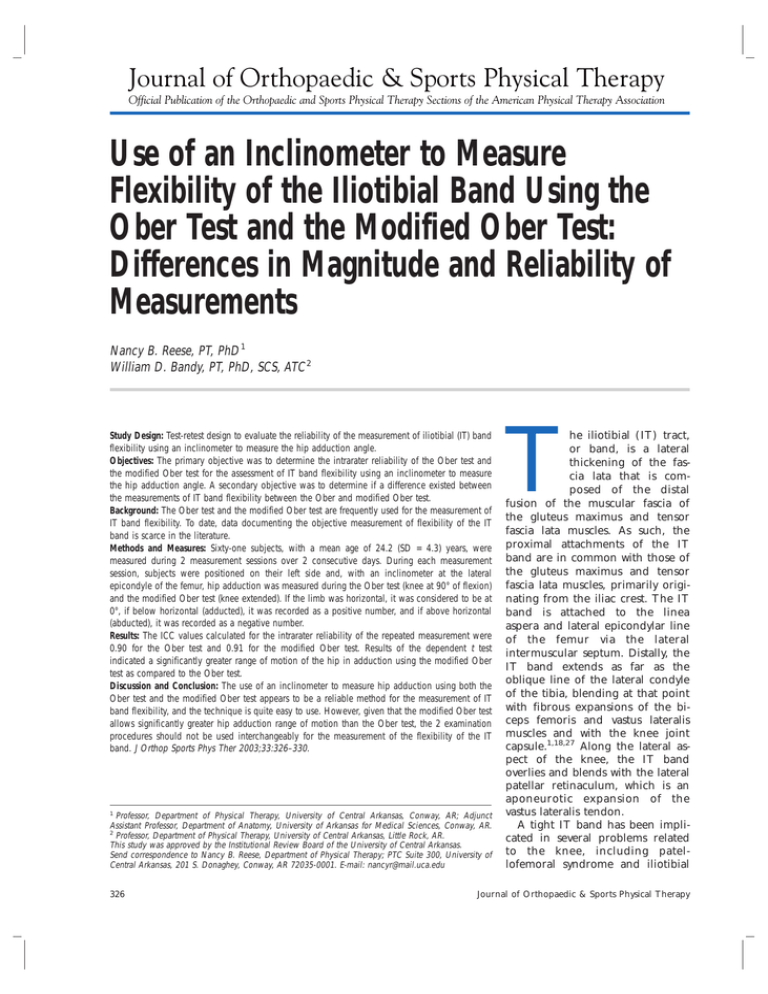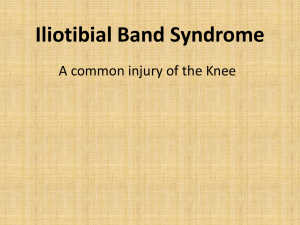Use of an Inclinometer to Measure
advertisement

Start/Renew Form Journal of Orthopaedic & Sports Physical Therapy Official Publication of the Orthopaedic and Sports Physical Therapy Sections of the American Physical Therapy Association Use of an Inclinometer to Measure Flexibility of the Iliotibial Band Using the Ober Test and the Modified Ober Test: Differences in Magnitude and Reliability of Measurements Please start my one-year subscription to the JOSPT. Please renew my one-year subscription to the JOSPT. Individual subscriptions are available to home addresses only. All subscriptions are payable in advance, and all rates include normal shipping charges. Subscriptions extend for 12 months, starting at the month they are entered or renewed (for example, September 2002-August 2003). Single issues are generally available at $20 per copy in the United States and $25 per copy when mailed internationally. Institutional Individual Student USA $215.00 $135.00 $75.00 International $265.00 $185.00 $125.00 Agency Discount $9.00 Subscription Total: $________________ Shipping/Billing Information Name _______________________________________________________________________________________________ 1 Nancy B. Reese, PT, PhD Address _____________________________________________________________________________________________ William D. Bandy, PT, PhD, SCS, ATC 2 Address _____________________________________________________________________________________________ City _______________________________State/Province __________________Zip/Postal Code _____________________ Phone _____________________________Fax____________________________Email _____________________________ Study Design: Test-retest design to evaluate the reliability of the measurement of iliotibial (IT) band he iliotibial (IT) tract, flexibility using an inclinometer to measure the hip adduction angle. or band, is a lateral Would you like to receive JOSPT email updates and renewal notices? Yes No Objectives: The primary objective was to determine the intrarater reliability of the Ober test and thickening of the fasthe modified Ober test for the assessment of IT band flexibility using an inclinometer to measure cia lata that is comthe hip adduction angle. A secondary objective was to determine if a difference existed between posed of the distal Payment Information the measurements of IT band flexibility between the Ober and modified Ober test. fusion of the muscular fascia of Background: The Ober test and the modified Ober test are frequently used for the measurement of Check enclosed (made payable to the JOSPT). the gluteus maximus and tensor IT band flexibility. To date, data documenting the objective measurement of flexibility of the IT fascia lata muscles. As such, the is scarce the literature. band Credit Card in (circle one) MasterCard VISA American Express Methods and Measures: Sixty-one subjects, with a mean age of 24.2 (SD = 4.3) years, were proximal attachments of the IT measured during 2 measurement sessions over 2 consecutive days. During each measurement band are in common with those of Card Number ___________________________________Expiration Date _________________________________________ session, subjects were positioned on their left side and, with an inclinometer at the lateral the gluteus maximus and tensor epicondyle of the femur, hip adduction was measured during the Ober test__________________________________________________ (knee at 90° of flexion) fascia lata muscles, primarily origiSignature ______________________________________Date and the modified Ober test (knee extended). If the limb was horizontal, it was considered to be at nating from the iliac crest. The IT 0°, if below horizontal (adducted), it was recorded as a positive number, and if above horizontal band is attached to the linea (abducted), it was recorded as a negative number. aspera and lateral epicondylar line To order call, email or mail Results: The ICC values calculated for the intrarater reliability of thefax, repeated measurement wereto: of the femur via the lateral 0.90 for the Ober test and 0.911111 for the modified Ober test. Results of the Alexandria, dependent t test North Fairfax Street, Suite 100, VA 22314-1436 intermuscular septum. Distally, the indicated a significantly greater range of motion of the hip in adduction using the modified Ober Phone 877-766-3450 • Fax 703-836-2210 • Email: subscriptions@jospt.org IT band extends as far as the test as compared to the Ober test. oblique line of the lateral condyle Discussion and Conclusion: The use of an inclinometer to measure hip adduction using both the Thank you for subscribing! Ober test and the modified Ober test appears to be a reliable method for the measurement of IT of the tibia, blending at that point band flexibility, and the technique is quite easy to use. However, given that the modified Ober test with fibrous expansions of the biallows significantly greater hip adduction range of motion than the Ober test, the 2 examination ceps femoris and vastus lateralis procedures should not be used interchangeably for the measurement of the flexibility of the IT muscles and with the knee joint capsule.1,18,27 Along the lateral asband. J Orthop Sports Phys Ther 2003;33:326–330. pect of the knee, the IT band overlies and blends with the lateral patellar retinaculum, which is an aponeurotic expansion of the 1 Professor, Department of Physical Therapy, University of Central Arkansas, Conway, AR; Adjunct vastus lateralis tendon. Assistant Professor, Department of Anatomy, University of Arkansas for Medical Sciences, Conway, AR. A tight IT band has been impli2 Professor, Department of Physical Therapy, University of Central Arkansas, Little Rock, AR. cated in several problems related This study was approved by the Institutional Review Board of the University of Central Arkansas. Send correspondence to Nancy B. Reese, Department of Physical Therapy; PTC Suite 300, University of to the knee, including patelCentral Arkansas, 201 S. Donaghey, Conway, AR 72035-0001. E-mail: nancyr@mail.uca.edu lofemoral syndrome and iliotibial T 326 Journal of Orthopaedic & Sports Physical Therapy J Orthop Sports Phys Ther • Volume 33 • Number 6 • June 2003 FIGURE 1. Measurement procedure for the Ober test (knee flexed to 90°) with an inclinometer. Note that the examiner holding the extremity is masked to the values of the inclinometer. FIGURE 2. Measurement procedure for the modified Ober test (knee fully extended) with an inclinometer. Note that the examiner holding the extremity is masked to the values of the inclinometer. Several methods have been described in the literature for quantifying the results of the Ober test and modifications of the Ober test ranging from observation8,11,20 to the use of a goniometer,23 tape measure, 3 and inclinometer. 17 Ober 20 relied on observation to quantify the results, stating that ‘‘if there is no contracture present, the thigh will adduct beyond the median line.’’ Hoppenfeld11 suggested that when performing the Ober test, if the IT band is ‘‘normal,’’ the thigh should drop to the adducted position, and if ‘‘contracture’’ is present in the IT band, the thigh should remain abducted. Gose and Schweizer8 presented a slightly more sophisticated classification system describing the position of the lower extremity relative to the horizontal body plane: ‘‘If the leg can be passively stretched to a position horizontal but not completely adducted to the table, it constitutes ‘minimal’ tightness, especially in the 327 RESEARCH REPORT band friction syndrome. Several authors have suggested that tightness in the IT band may contribute to patellofemoral syndrome and knee pain by pulling the patella laterally, thereby causing abnormal tracking of the patella in the trochlear groove.3,4,16,21 Iliotibial band friction syndrome, in which a tight IT band rubs over the lateral femoral epicondyle prominence with repetitive flexion and extension of the knee, has been reported as a relatively common condition in cyclists, ballet dancers, and runners, and has been attributed to the lack of flexibility of the IT band.9,10,15,19,23,26 Across all of these reports in the literature related to the tight IT band and the problems that result from this lack of flexibility, the examination for IT band tightness that has consistently been advocated by each of these authors as the examination of choice is the Ober test or a modification of the Ober test. The original Ober test was described in 1935 as a test to examine the relationship between tightness in the IT band and low back pain and sciatica. As originally described by Ober,20 the patient is positioned on the side with the extremity to be tested facing upward. The examiner flexes the knee to be tested to 90° and abducts and extends the hip so that the hip is in line with the trunk. At this point, the examiner allows the force of gravity to cause the extremity to adduct as far as possible (Figure 1). Today, this test (known as the Ober test) is used not only to examine length of the IT band for individuals with low back pain, but also to examine flexibility of the IT band in all individuals. In a modification to the original Ober test, Kendall13 suggested that the examiner should keep the knee extended in the extremity to be tested (as opposed to flexing the knee to 90° as originally described by Ober) while performing the examination (Figure 2). This was referred to as the ‘‘modified Ober test,’’ and Kendall13 rationalized that keeping the extremity in extension during the test caused less stress to the medial aspect of the knee, less tension on the patella, and less potential interference by a tight rectus femoris muscle. Melchione and Sullivan17 suggested that the modified Ober test was a more functional test position. In reviewing the literature, the Ober test and modified Ober test appear to be used with equal frequency; one version of the test has not been shown to be more popular, accurate, or easier to perform than the other version.7,12,14 Although Puniello21 states that the IT band is pulled posteriorly with knee flexion, there is no agreement in the literature regarding the position of the knee (flexion versus extension) that creates the greatest tension on the IT band.7,12,14 Therefore, prior to this study, there was no supposition that one test (the Ober test or the modified Ober test) would result in greater or less hip adduction range of motion than the other. proximal fascia. If the leg can be passively adducted to horizontal at best, it constitutes ‘moderate’ tightness of the iliotibial band and proximal fascia . . . If the leg cannot passively be adducted to horizontal, this constitutes a maximal contracture of the iliotibial band throughout its expanse.’’ Reid et al23 suggested the use of a goniometer to quantify muscle length of the iliotibial band and tensor fascia lata during performance of the Ober test. The axis of the goniometer was placed at the ipsilateral anterior superior iliac spine, with the stationary arm of the goniometer parallel to the support surface (horizontal) and the moving arm aligned along the long axis of the adducting thigh and pointed toward the mid patella. Zero degrees was documented when the thigh was horizontal, a positive value was recorded if the thigh was adducted past horizontal, and a negative value was recorded if the thigh did not adduct to horizontal. Gajdosik et al7 used similar goniometric procedures to measure IT band flexibility, but used positive values if the limb remained abducted beyond horizontal and negative values if the limb adducted past horizontal. The use of a tape measure to quantify muscle length was described by Douchette and Goble.3 Subjects were placed in the Ober test position and the distance between the medial border of the patella and the support surface was measured. Melchione and Sullivan17 described the use of an inclinometer placed at the distal lateral thigh of the extremity on which the modified Ober test was performed. Reports on the reliability of any of the measurement techniques (obser vation, tape measure, goniometer, inclinometer) used to quantify the Ober test or modification of the Ober test are few. Using a goniometer to measure IT band flexibility in men and women using the Ober test and the modified Ober test, Gajdosik et al7 reported intrarater reliability ranging from 0.82 to 0.92. Using an inclinometer placed at the distal lateral thigh of the extremity in which the modified Ober test was performed, Melchione and Sullivan17 reported intrarater reliability of 0.94 in their test-retest study design with 10 subjects. Given that the Ober test and the modified Ober test are the predominant examination tools for the measurement of flexibility of the IT band, and given that data documenting the objective measurement of the IT band are scarce in the literature, information is needed to document if the Ober or the modified Ober test will provide accurate data and reliable information related to the flexibility of the IT band. Therefore, the primary purpose of this study was to determine the intrarater reliability (accuracy of same examiner) of the Ober test and the modified Ober test for the measurement of IT band flexibility using an inclinometer. If appropriate reliability was established during this study, then a secondary purpose of the investigation was to determine if a difference 328 existed between IT band flexibility (measured as hip adduction) as measured using the Ober test and the modified Ober test. METHODS Subjects Sixty-one subjects (17 males, 44 females) with a mean age of 24.2 (SD = 4.3) years were recruited for this study. All subjects underwent an initial screening to ensure that they were pain free and did not have any musculoskeletal or neurologic dysfunction of the lower extremities at the time of data collection. Subjects were informed of the purpose of the study and the procedures to be used, and signed an informed consent form prior to data collection. The protocol for this study was approved by the Institutional Review Board of the University of Central Arkansas. Examiners Three investigators participated in the measurement of IT band flexibility: examiner 1 possessed 20 years of experience in orthopaedic physical therapy and was responsible for performing the Ober and modified Ober test; examiner 2 had 20 years of experience in measuring joint range of motion and was responsible for placing the inclinometer; and the third individual was a graduate student in physical therapy who was involved in reading the inclinometer once it was positioned and recording the data. Equipment An inclinometer is a circular, fluid-filled instrument with a weighted needle that indicates the number of degrees on a scale of a protractor. An inclinometer with markings at 1° increments was used for all measurements. During data collection, the examiners who performed the test and placed the measurement device were not allowed to view the inclinometer. Procedures Data were collected during 2 measurement sessions. The IT band of the left lower extremity was arbitrarily chosen for measurement. Prior to data collection, random procedures were used to determine the order of the measurement technique used to measure IT band flexibility (Ober test versus modified Ober test). Once the initial technique was randomly chosen, IT band flexibility was measured using the positioning described by Reese and Bandy.22 The subjects were positioned on their right side with the hip and knee of the right lower extremity (against the support surface) flexed to 45° and 90°, respectively, in order to stabilize the pelvis. J Orthop Sports Phys Ther • Volume 33 • Number 6 • June 2003 Data Analysis Means and standard deviations were calculated for the measurements obtained for both the Ober test and the modified Ober test for the first day and on the second day of data collection. Intrarater reliability of the measurements was assessed with 2 separate intraclass correlation coefficients (ICC3,2): 1 to examine the intrarater reliability of the Ober test, and 1 to examine the intrarater reliability of the modified Ober test. Finally, a dependent t test was used to examine if a significant difference existed between the measurement of IT band flexibility performed using the Ober J Orthop Sports Phys Ther • Volume 33 • Number 6 • June 2003 test or the modified Ober test. Day 1 data were used for this analysis. The level of significance was set at P <.05. RESULTS Descriptive statistics for measurement of day 1 and day 2 for both the Ober test and the modified Ober test are presented in the Table. The ICC values calculated for the between-days intrarater reliability of the repeated measurement was 0.90 for the Ober test and 0.91 for the modified Ober test. Results of the dependent t test indicated a significant difference (P <.001) in the range of motion of the hip between the Ober test (mean ± SD = 18.9° ± 7.6°) and the modified Ober test (mean ± SD = 23.4° ± 7.0°). The actual measurement difference between the Ober test and the modified Ober test was 4.5°. DISCUSSION This study is one of the first investigations to quantify the measurement of IT band flexibility using the Ober test and the modified Ober test with an inclinometer. Several authors suggest that intratester reliability in a test-retest design needs to be above 0.80 to be considered acceptable.2,5,6 The correlation coefficients for intrarater reliability achieved in this study of greater than 0.90, irrespective of whether the Ober test or modified Ober test was used, indicate that more than acceptable reliability was achieved according to these previously referenced authors. Although Melchione and Sullivan17 reported excellent reliability (ICC = 0.94) using an inclinometer, several differences exist between their study and the present one. First, the sample size of 10 was very low, and second, only the reliability of the modified Ober test was evaluated. Additionally, the technique used by Melchione and Sullivan17 was quite complex, with the authors using a pelvic level and 2 universal goniometers to maintain pelvic position. The present study showed excellent reliability for both the Ober test and the modified Ober test using a technique that was much more simple and easy to use. The results, which indicate that there is significantly greater hip adduction range of motion with TABLE Hip adduction position (mean ± standard deviation) representative of iliotibial band flexibility, using the Ober test and modified Ober test performed on 2 consecutive days (measured in degrees). Technique Ober test Modified Ober test Day 1 Day 2 18.9 ± 7.6* 23.4 ± 7.0 18.6 ± 6.9 23.0 ± 6.8 *Values obtained for the Ober test on day 1 were significantly different than values for the modified Ober test on that same day. 329 RESEARCH REPORT Examiner 1 placed the right hand on the ipsilateral pelvis to stabilize it by pushing in a superior and downward direction. Examiner 1 then used the left hand to, first, passively abduct the hip, and second, to extend the subject’s left hip in line with the trunk. Examiner 1 then asked the subject to relax all muscles of the lower extremity while allowing the uppermost limb to drop into adduction toward the table through the available hip adduction range of motion. As the limb dropped toward the table, examiner 1 supported the limb at the medial joint in order to lower the limb with greater control (Figures 1 and 2). In addition, this support hand prevented flexion and internal rotation of the hip. The end position of hip adduction was defined as the point at which lateral tilting of the pelvis was palpated, when the hip adduction movement stopped, or both. When performing the Ober test, examiner 1 maintained the subject’s knee in 90° of flexion (Figure 1). When performing the modified Ober test, examiner 1 maintained the subject’s knee in full extension (Figure 2). In this position, examiner 1 maintained the alignment and ensured that no tilting of the pelvis and no internal rotation and flexion of the hip occurred, while examiner 2 placed the inclinometer over the lateral epicondyle. Examiner 2 positioned the inclinometer so that the measurement scale was facing away from examiners 1 and 2. Examiner 3 then read the scale of the inclinometer (Figures 1 and 2). If the limb was horizontal, it was considered 0°; if below horizontal (adducted), it was recorded as a positive number; and if above horizontal (abducted), it was recorded as a negative number. Each measurement (Ober test versus modified Ober test) was repeated twice during the measurement session. An average of the 2 measurements was used for later analysis. One day later, the same procedures used to measure IT band flexibility with the Ober and modified Ober test were repeated. The researchers did not have information about the measurements collected on the first day when performing measurements of the IT band on the second day. the modified Ober test (knee extended) than with the Ober test (knee flexed), are consistent with previous results reported by Gajdosik et al,7 even though these authors used a different measurement tool. The present study indicated that the difference in these 2 tests was nearly 5°, while Gajdosik et al7 reported a difference of 10° (sample size was 49). However, larger sample sizes would be needed before any ‘‘normal’’ values should be discussed. One possible explanation for the greater hip adduction range of motion observed when performing the Ober test with the knee extended rather than flexed may be secondary to the blending of fibers of the IT band and vastus lateralis tendon. Increased tension in the vastus lateralis muscle, caused by the flexed knee position, could in turn result in lengthening of the IT band through their common attachments. Gajdosik et al7 allude to such a phenomenon as an explanation for the increased hip adduction they observed in the knee-extended position. However, anatomical and biomechanical studies fail to substantiate such an argument, asserting instead that the IT band tightens as the knee approaches extension.24,25 A second possible explanation for greater hip adduction range of motion with the modified Ober test (knee extended) than the Ober test (knee flexed) might be due to the inability to control the pelvis. The extended knee position may have allowed a greater passive torque to be applied across the IT band and provide a greater pull on the pelvis, thereby resulting in an increased range of hip adduction. However, no difficulty in stabilizing the pelvis was reported by the examiner. By supporting the limb being measured at the medial joint line with 1 hand and stabilizing and palpating pelvic tilting with the other hand, the examiner easily controlled the hip adduction movement and felt when the defined end range of hip adduction occurred. CONCLUSION The use of an inclinometer for the measurement of IT band flexibility using both the Ober test and the modified Ober test appears to be reliable and the technique is quite easy to use. However, given that the modified Ober test demonstrated significantly greater hip range of motion than the Ober test, the 2 examination procedures should not be used interchangeably for the measurement of the flexibility of the IT band. REFERENCES 1. Clemente CD. Gray’s Anatomy. 13th ed. Philadelphia, PA: Lea and Febiger; 1985. 2. Currier DP. Elements of Research in Physical Therapy. 2nd ed. Baltimore, MD: Williams and Wilkins; 1984. 330 3. Doucette SA, Goble EM. The effect of exercise on patellar tracking in lateral patellar compression syndrome. Am J Sports Med. 1992;20(4):434–440. 4. Ekman EF, Pope T, Martin DF, Curl WW. Magnetic resonance imaging of iliotibial band syndrome. Am J Sports Med. 1994;22(6):851–854. 5. Elveru RA, Rothstein JM, Lamb RL. Goniometric reliability in a clinical setting. Subtalar and ankle joint measurements. Phys Ther. 1988;68(5):672–677. 6. Fleiss JJ, Cohen J. The equivalence of weighted kappa and intraclass correlation coefficients as measures of reliability. Educ Psychol Meas. 1973;33:613–619. 7. Gajdosik RL, Sandler MM, Marr HL. Influence of knee positions and gender on the Ober test for length of the iliotibial band. Clin Biomech (Bristol, Avon). 2003;18(1):77–79. 8. Gose JC, Schweizer P. Iliotibial band tightness. J Orthop Sports Phys Ther. 1989;10(4):399–407. 9. Hilyard A. Recent developments in the management of patellofemoral pain: the McConnell programme. Physiother. 1990;76:559–565. 10. Holmes JC, Pruitt AL, Whalen NJ. Iliotibial band syndrome in cyclists. Am J Sports Med. 1993;21(3):419– 424. 11. Hoppenfeld S. Physical Examination of the Spine and Extremities. Norwalk, CT: Appleton and Lange; 1976. 12. Kaplan EB. Some aspects of functional anatomy of the human knee joint. Clin Orthop. 1962;23:18–29. 13. Kendall HO. Posture and Pain. Baltimore, MD: Williams and Wilkins; 1953. 14. Kendall FP, McCreary EK. Muscle Testing and Function. 4th ed. Baltimore, MD: Williams and Wilkins; 1994. 15. Linenger JM, Christensen CP. Iliotibial band syndrome often overlooked? Phys Sportsmed. 1992;20:98–100. 16. McConnell J. The management of chondromalacia patellae: a long-term solution. Aust J Physiother. 1986;32:215–233. 17. Melchione WE, Sullivan MS. Reliability of measurements obtained by use of an instrument designed to indirectly measure iliotibial band length. J Orthop Sports Phys Ther. 1993;18(3):511–515. 18. Moore KL, Dalley AF. Clinically Oriented Anatomy. 4th ed. Philadelphia, PA: Williams and Wilkins; 1999. 19. Noble HB, Hajek MR, Porter M. Diagnosis and treatment of iliotibial band tightness in runners. Phys Sportsmed. 1982;10:67–74. 20. Ober FR. Back strain and sciatica. JAMA. 1935;104: 1580–1581. 21. Puniello MS. Iliotibial band tightness and medial patellar glide in patients with patellofemoral dysfunction. J Orthop Sports Phys Ther. 1993;17(3):144–148. 22. Reese NB, Bandy WD. Joint Range of Motion and Muscle Length Testing. Philadelphia, PA: Saunders Co.; 2002. 23. Reid DC, Burnham RS, Saboe LA, Kushner SF. Lower extremity flexibility patterns in classical ballet dancers and their correlation to lateral hip and knee injuries. Am J Sports Med. 1987;15(4):347–352. 24. Terry GC, Hughston JC, Norwood LA. The anatomy of the iliopatellar band and iliotibial tract. Am J Sports Med. 1986;14(1):39–45. 25. Wang CJ, Walker PS. The effects of flexion and rotation on the length patterns of the ligaments of the knee. J Biomech. 1973;6(6):587–596. 26. Winslow J, Yoder E. Patellofemoral pain in female ballet dancers: correlation with iliotibial band tightness and tibial external rotation. J Orthop Sports Phys Ther. 1995;22(1):18–21. 27. Woodburne RT. Essentials of Human Anatomy. 9th ed. New York, NY: Oxford University Press; 1997. J Orthop Sports Phys Ther • Volume 33 • Number 6 • June 2003




![Slides []](http://s2.studylib.net/store/data/010094144_1-34514839af8115dfe1053b020d498ea1-300x300.png)